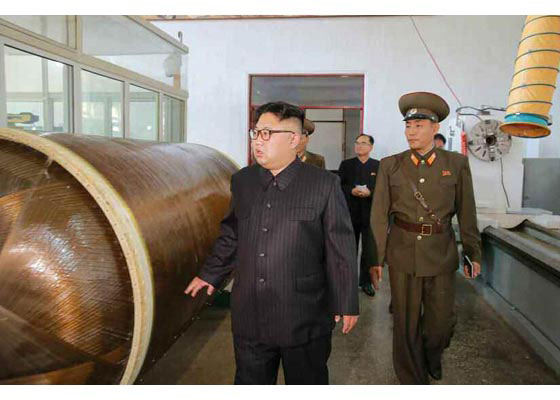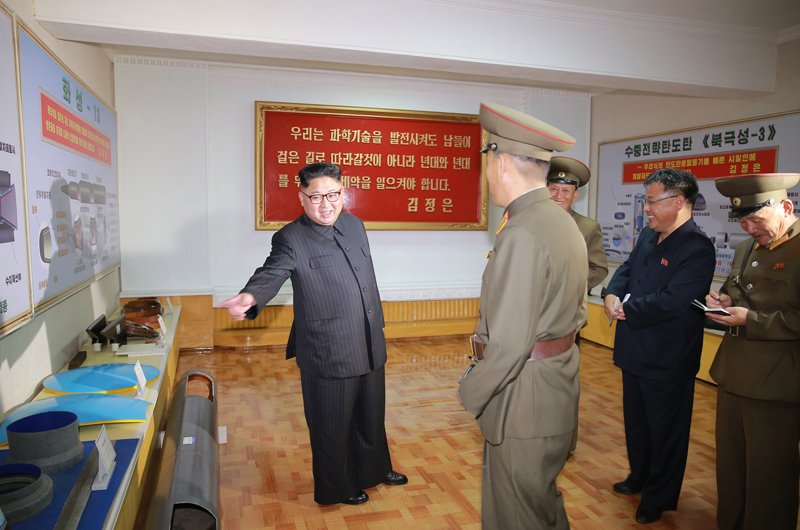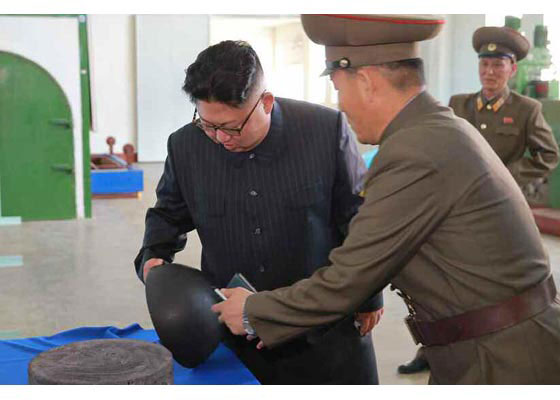Kim’s Visit to the Chemical Material Institute: A Peek Into North Korea’s Missile Future
Photos of Kim Jong Un’s recent visit to the Chemical Material Institute of the Academy of Defence Sciences revealed machinery critical to advancing North Korea’s solid-fuel missile technology, as well as diagrams of designs for two missiles that have never been tested. During his field guidance, Kim inspected a large filament-wound composite vessel and an assortment of carbon-based materials suitable for use on ballistic missiles and essential for improving solid-fuel missile performance. Two large posters were also captured in the photos, presenting conceptual illustrations of a new missile, the Pukguksong-3, and the Hwasong-13 (also known as the KN-08), as well as the technical parameters for their composite materials.

The large bronze-colored vessel examined by Kim Jong Un is an advanced, light-weight casing designed to house solid propellant. Its size, roughly 1.4-1.5 meters in diameter, is consistent with North Korea’s two existing solid-fuelled missiles: the submarine-based Pukguksong-1 and the land-based Pukguksong-2. In the background, behind a window, a filament-winding machine can be seen. It is presumably used to manufacture the composite-motor casing.[1] It is unclear if the machine can produce motor casings larger than a 1.5 meter diameter. If not, North Korea will need to acquire a larger winding machine to produce motor casings large enough to power intercontinental ballistic missiles (ICBMs).

The new missile seen in the conceptual illustration (on the right wall) is the Pukguksong-3, which seems to be an advanced version of the solid-fuelled Pukguksong-1 and -2. Building the Pukguksong-3 using lighter-weight composite motor casings, instead of cases made from metal, should allow the new missile to fly further, though exactly how much further is difficult to determine. If North Korea masters the production processes, maintains a reliable supply chain for the filaments and resins needed to create the cases, and adheres to strict quality control procedures, the Pukguksong-3 might be capable of reaching targets 2,000 km away. Mastering the processes will likely require a few years of practice, and the range extension realized may be only a few hundred kilometers beyond the present reach of the Pukguksong-1 and -2, which is about 1,200 km.
The acquisition of filament-winding machines likely serves a longer-term objective: the creation of a solid-fuelled ICBM. While composite cases will certainly aid North Korea’s efforts to develop an ICBM based on solid propellants, the road will be long and the pace of development will be determined by the ability to produce reliably and with consistency very large solid-propellant motors. To date, the largest solid motor manufactured and test flown by the North is the Pukguksong’s first stage, which weighs about 6,000 to 7,000 kg. An ICBM first stage motor will be on the order of 20,000 kg. Using history as a judge, the step from producing 6-ton motors to 20-ton motors requires seven to 10 years of effort. North Korea might be able to shorten the timeframe by a few years by taking shortcuts and accepting reductions in performance and reliability. But given the country’s relative inexperience with solid-propellant production, an ICBM founded on solid-fuels is unlikely to be fielded within a decade.
Conceptual illustrations of the Hwasong-13 missile were also seen hanging on the opposite wall. The Hwasong-13/KN-08 was first unveiled during a 2012 military parade in Pyongyang, though it has not been tested. The illustrations are highly stylized and focus on the engine bays and the warhead’s nose tip, suggesting they are intended to highlight future use of composite materials for the missile’s interstages, structural elements and re-entry vehicle. While some analysts suggest this is a solid fuel design, it is difficult to determine this for certain based on the illustration, although the Hwasong-13 displayed in 2012 and in subsequent parades appear to be liquid fueled. The technical specifications of a 4D carbon-carbon composite are featured in another illustration. Carbon-based composite materials that ablate (melt) when exposed to high temperatures are ideal for protecting a warhead from the rigors of re-entry into the atmosphere at ICBM speeds.

- [1]
Solid-fueled rocket motors consist of a casing, solid propellant, an exhaust nozzle, ignitor and ancillary components. The motor casing acts as the missile’s structural framework, houses the solid propellant, and serves as the combustion chamber during operation. Motor casings are traditionally made from metal, such as aluminum alloys, maraging steel or titanium. However, to optimize performance, designers prefer to use high-strength, light-weight composite materials. Composite cases are made using thin aramid or carbon fibers bound together in an epoxy resin, similar to fiberglass. Specialized machines are used to impregnate the fibers with epoxy resin and wrap the fiber around a mold to create a large vessel or casing. The use of composite materials can improve missile performance significantly.
